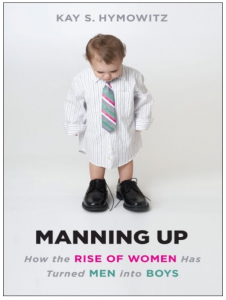For the past few years, I’ve kept a file on extended adolescence because it is one of the most common symptoms I see among the thousands of messages I receive each year from readers asking for advice. Often, they are dissatisfied with the way their life is going, yet they almost inevitably suffer from extended adolescence and the accompanying detriments that are intrinsic to the condition. Many of them fail to even realize it because they think they are high performers in other regards.
Aside from the frequency with which I see it from my position, the ascent of extended adolescence is having a tremendous influence on the broader culture, the nation’s economic future, and interpersonal relationships, making it interesting to me on not only an academic basis but as an investor, as well. I’m glad to see that the topic has been discussed more in the news lately. In fact, last year, The New York Times published a nearly 8,000 word essay called What Is It About 20-Somethings? that dealt extensively with the paradigm shift.
The Eight Stages of Human Development
Erik Erikson, the legendary psychologist who coined the phrase “identity crisis”, created a theory of human development that identified eight key stages in life. As he grew older, Erikson modified his stages model, eventually attaching specific attributes and experiences for each stage; this is a model used during the middle of his career with later models shifting the ages a bit:

Still living at home? Parents paying the bills? Still enrolled in college? Single? No children? Psychologists would argue it is time to grow up. Economists would argue it doesn’t bode well for the nation’s economic future. As investors, the rise of extended adolescence introduces an interesting curve ball to the demographic models that underscore many financial models.
- Infancy: Birth to 18 Months
- Early Childhood: 18 Months to 3 Years
- Play Age: 3 to 5 Years
- School Age: 6 to 12 Years
- Adolescence: 12 to 18 Years
- Young Adulthood: 18 to 35 Years
- Middle Adulthood: 35 to 55 or 65 Years
- Late Adulthood: 55 or 65 to Death
The Five Traditional Milestones of Adulthood
Something magically happens between adolescence and young adulthood. There are five traditional milestones of that mark entrance into adulthood that sociologists, psychologists, and the general population have used as a proxy to determine when someone has reached that tipping point of maturity. It is at this time adolescence is shed and emotional maturity comes to full fruition. These are:
- Leaving Home
- Becoming Financially Independent
- Completing School
- Marrying
- Starting a Family (not applicable if the person makes a conscious choice not to have children or is infertile; this choice has been shaped by the relatively recent discovery of female birth control)
As per the practice of mathematician Jacobi (who, as Charlie Munger reminds us, urged his followers to “invert! Always invert!” as a way to solve problems), someone who was suffering from extended adolescence would:
- Still live at home or in a home paid for by parents or other family member
- Still rely on parents or other family member to cover living expenses in whole or part
- Still be enrolled in school in some capacity
- Single
- No Children
[mainbodyad]In some ways, it is almost impossible for me to see how someone can live in extended adolescence because virtually all (upwards of 90% or more) of my close friends and family have been married for at least a few years, have one or two kids at home, are financially independent, successful in their careers, and happy. I don’t talk much about my personal life on the blog for privacy reasons, but those who are around me in real life know my days these past few years are filled with baby showers, brunches, and birthday parties for the under-five-years-old crowd. It isn’t unusual for me to be sitting on a sofa reading an annual report as a three-year old pretend flatirons my hair followed by a pretend blow dry and nail polish.
Then again, I always said that the primary mission of my life was family, with my career coming a close second. By all of the metrics except children, which have been scheduled since I was a teenager down to a very specific age range that correlated with a much larger plan, I reached adulthood at around 19 years old (my wealth coming from my own businesses, my college education was to better myself, not to get a job so it was unnecessary for my career even though it was one of the best things I’ve ever done). My parents reached it at 18 and 20, respectively. Most of the people around me reached it before they were 24 years old.
Real World Examples of Adulthood vs. Extended Adolescence
To understand these, it might help to frame them within real-world situations.
Examples of Adults:
- A 25-year old teacher with a college degree, who works full time, is married, has a child, owns her own home, and pays for her own living expenses
- A 65-year old janitor with a high school diploma, who works full time, is married or widowed, has children, owns his own home, and pays for his own living expenses
Examples of Extended Adolescence:
- A 30-year old who has part of their rent and bills covered by parents, endlessly enrolls in colleges or universities seeking additional degrees or credentials, single, without children.
- A 45-year old high-school dropout living on social welfare programs who spends his days getting drunk in bars
The Cost of Extended Adolescence Is Much Higher for Women
What is particularly interesting is the interaction between biology and the paradigm shift that has occurred with so much of the younger generation suffering from extended adolescence. Women have a specific, limited window of time in which they can genetically reproduce and to which they are attractive to potential mates. This so-called “biological clock”, written into the code at the very deepest core of our DNA, puts a limit on childbearing for females.
- Fertility: Female fertility peaks at 20 to 30 years old. After 30 years old, fertility drops by 20%. After 35, it drops 50%. After 40, it drops 95%. As for in vitro fertilization, the American Society for Reproductive Medicine states that women in their early 40’s have, on average, only a 3% to 5% chance of having a baby through this method.
- Down Syndrome: At 25, a woman has about 1 chance in 1,250 of having a baby with Down Syndrome; at age 30, a 1-in-1,000 chance; at age 35, a 1-in-400 chance; at age 40, a 1-in-100 chance; and at 45, a 1-in-30- chance.
- Miscarriage: Only 9 percent of recognized pregnancies for women aged 20 to 24 end in miscarriage; 15 percent of women aged 25-30 miscarry; 40 percent of women over 40 do and more than 50 percent miscarry at 42 years of age.
These limitations do not apply to men (an 80 year old man can still reproduce). Men have virtually no opportunity cost to waiting to find a mate. If they want to spend their twenties working their way up their field, putting money in the bank, playing video games, and hanging out with friends, they can always wake up one morning and decide they are ready to settle down, get married, and have kids. As such, the biological cost of extended adolescence is significantly and substantially higher for women than it is for men. Females suffer from a Mother Nature-induced “use it or lose it” policy.

In Manning Up, author Kay Hymowitz argues that societal changes have created a delayed adolescence in men. Specifically, Hymowitz focuses on men living in extended adolescence, resulting in successful women being unable to find suitable partners as they run up against the inevitable decline in fertility that begins at 30 and accelerates at 35.
This fear was encapsulated by Kay Hymowitz in a book called Manning Up: How the Rise of Women Has Turned Men Into Boys. To paraphrase Hymowitz: The rules of society may have changed but sex appeal has not. It’s an interesting read. If you aren’t up for the entire book, you can at least check out a preview and excerpt in The Wall Street Journal article called Where Have the Good Men Gone?.
As one reviewer somewhat critically noted of the book, “Hymowitz wants the child-men [those suffering from extended adolescence] to man up so that women don’t have to become spinsters or “choice mothers” at the expense of their careers. Might women alter their own behavior? “[T]he economic and cultural changes are too embedded, and, for women especially, too beneficial to reverse.” So the answer is no. Although it is women who are becoming disenchanted with the way things are, and although it is women who have created this situation, it is [in her opinion] men who ought to change. And they are to change precisely when women are ready.”
The reviewer is correct because men are acting rationally within the confines the new paradigm. In today’s world, men are presented no social, financial, emotional, or reproductive advantage by adjusting their own life to the ticking of a potential mate’s biological clock. It is for the woman, to borrow a phrase, “too damn bad”. It may not be fair, but in a finite world, there is an opportunity cost to every decision we make. That has always been one of the central themes of this blog. Incentive systems drive nearly everything in civilization from the type of people we attract into certain industries to the kind of behavior we reward. The incentive system for men has changed and society now reflects this reality. As such, the men who become adults early in life are the ones who desire the family, kids, and independence long associated with responsible manhood.
What should be done? Is there a cure to extended adolescence? What are the economic, social, and political ramifications of the rise of extended adolescence beyond the inevitable insolvency of social welfare programs? Where do we go from here?
[mainbodyad]


